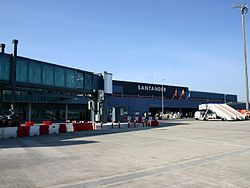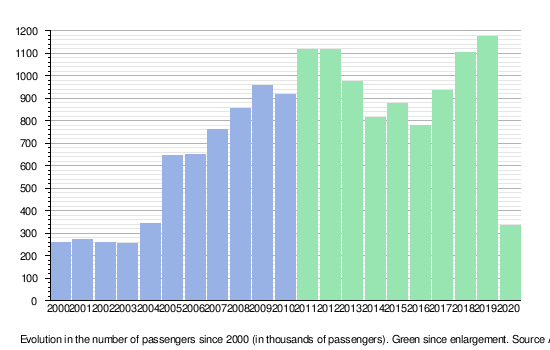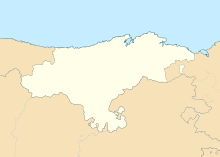Santander_Airport
Santander Airport
Airport in Cantabria, Spain
Santander Airport (IATA: SDR, ICAO: LEXJ), officially Seve Ballesteros–Santander Airport, is an international airport near Santander, Spain and the only airport in Cantabria. In 2018 the airport handled 1,103,353 passengers and 11,258 flights, far more than in 1995 when it handled only 180,000 passengers. Since then, the traffic has declined following the trend in Spanish airports and the decrease in operations by some of the companies. [citation needed]
This article needs additional citations for verification. (August 2015) |
Santander Airport Aeropuerto Seve Ballesteros - Santander | |||||||||||
|---|---|---|---|---|---|---|---|---|---|---|---|
 | |||||||||||
 | |||||||||||
| Summary | |||||||||||
| Airport type | Public | ||||||||||
| Owner/Operator | Aena | ||||||||||
| Location | Maliaño, Camargo, Cantabria, Spain | ||||||||||
| Elevation AMSL | 16 ft / 5 m | ||||||||||
| Coordinates | 43°25′37″N 03°49′12″W | ||||||||||
| Website | aena-aeropuertos.es | ||||||||||
| Map | |||||||||||
| Runways | |||||||||||
| |||||||||||
| Statistics (2019) | |||||||||||
| |||||||||||
The airport has a single runway, runway 11/29, with a length of 2,420 m / 7,612 ft. Runway 29 ends about 20 meters next to the Bay of Santander and runway 11 ends about 150 meters from the highway S-10 and a shopping center. Since 2021, there is a precision approach lighting system at runway 29.
The airport is named after the famous golf player Seve Ballesteros, born in Pedreña, a few kilometres from the airport and being one of the most well known public figures of Cantabria in the last century. The airport was known as 'Santander Airport' until 2015. In May 2014, a popular initiative taken to the Parliament of Cantabria was unanimously approved to change the name after Ballesteros. The Spanish government approved the change on 16 April 2015.[2]
The current airport, built on ground reclaimed from the Bay of Santander, was opened to traffic in 1977. A smaller airfield was built on the location between 1947 and 1952 by prisoners of the Spanish Civil War.[citation needed] It opened in 1953, replacing the old Santander airport located in La Albericia, which received commercial flights since 1949, and received the name of Aeropuerto de Santander and popularly known as "Parayas". It received the international rating in 1957.[citation needed]
After a three-year closure (from April 1974 until 8 August 1977), in which the airport underwent a major renovation that significantly expanded its facilities and had a cost of more than 1,100 million pesetas of the time; it was reopened with a new 2,400 m runway and with the technology to allow both visual and instrumental flight; the first flight after the renovation corresponded to the Iberia's DC-9 "Ciudad de Santander", that covered the Barcelona-Santander-Santiago de Compostela route.[3]
In recent years there have been new renovation works, that started in 2007, remodeling and expanding the terminal and installing two gateways or fingers for direct access to the planes, widening the platform for parking more aircraft or construction of taxiways and a platform for general aviation.[4]
Until 2003 the premises were considered underused due to the limited number of flights and their high fees, which made a shift in potential passengers to the airport of Bilbao, 100 km away. From this date, following an agreement signed between the Government of Cantabria and the budget airline Ryanair, the airport experimented an increase in the number of destinations (national and international), passengers and airlines operating. In 2005 the airport reached 644,662 passengers, growing by 88% over the previous year and having a user balance between domestic and international flights. This increase was the largest proportion of all airports in Spain in that year.[5]
In December 2010, 37.8 million euro was invested for the upgrading of the facilities, preparing the airport to handle an annual traffic of over two million passengers a year. The works included the remodeling of the terminal building of 10,200 meters square, expanding new areas of departures and arrivals as well as the construction of a taxiway that can handle 22 movements per hour, and the extension of the aircraft parking platform.[6]
After the implementation of the renovations referred to in the airport master plan, today it has 8 check-in desks, 3 baggage carousels in the arrivals lounge and 7 boarding gates. As an international airport, it is also capable of handling flights from countries outside the Schengen zone.[7]
The following airlines operate regular scheduled and charter flights at Santander Airport:
| Airlines | Destinations |
|---|---|
| Binter Canarias | Gran Canaria,[8] Tenerife–North[9] |
| Iberia | Madrid Seasonal: Granada, Jerez de la Frontera, Vigo |
| Ryanair | Beauvais,[10] Bergamo, Birmingham, Charleroi, Dublin, Edinburgh, London–Stansted, Málaga, Manchester,[11] Marrakech, Rome–Fiumicino, Treviso, Valencia, Vienna Seasonal: Alicante,[12] Barcelona, Bologna |
| Volotea | Seville Seasonal: Ibiza, Menorca, Murcia[13] |
| Vueling | Barcelona Seasonal: Palma de Mallorca |
| Wizz Air | Seasonal: Bucharest–Otopeni |

Traffic per year[14]
| 2000 | 2001 | 2002 | 2003 | 2004 | 2005 | 2006 | 2007 | 2008 | 2009 | 2010 |
|---|---|---|---|---|---|---|---|---|---|---|
| 260,767 (+16.1%) 29th | 272,383 (+4.5%) 28th | 262,070 (-3.8%) 29th | 253,756 (-3.2%) 29th | 342,559 (+35.0%) 28th | 644,662 (+88.1%) 27th | 649,447 (+0.7%) 27th | 761,780 (+17.3%) 27th | 856,606 (+12.4%) 27th | 958,157 (+11.9%) 26th | 918,470 (-4.1%) 26th |
| 2011 | 2012 | 2013 | 2014 | 2015 | 2016 | 2017 | 2018 | 2019 | ||
| 1,116,398 (+21.4%) 21st | 1,117,617 (+0.1%) 20th | 974,043 (-12.8%) 20th | 815,636 (-16.3%) 23rd | 875,920 (+7.4%) 22nd | 778.318 (-11,1%) 26th | 937.641 (+20,5%) 26th | 1,103,353 (+17.7%) 25th | 1,174,896 (+6.5%) 22nd |
The road access by car is from the S-10 highway, exit 3 and then taking the road N-636 that leads to the airport facilities. There is also a regular bus line from Santander's main bus station in the city centre. The line buses from ALSA also stop in the airport prior booking in the routes that connect Santander with other towns in northern Spain like Bilbao, Gijón, Oviedo or Laredo[15].[16]
- http://www.aena.es/es/aeropuerto-santander/presentacion.doc . Aena.es. Retrieved on 20-02-2015.
- "Parayas ya se llama oficialmente 'Aeropuerto Seve Ballesteros-Santander". El Diario Montañes. 16 April 2015.
- Gran Enciclopedia de Cantabria. Santander: Ed. Cantabria. ISBN 978-84-86420-00-0.
- "El aeropuerto de Parayas estrena instalaciones". El Diario Montañes. 17 December 2010.
- Santander Official Airport website. Aena.es. Retrieved on 24-10-2012.
- Liu, Jim. "Binter adds Santander / Vitoria service in S20". Routesonline. Retrieved 27 January 2020.
- "Ryanair conectará Santander con Manchester y París". Cantabria Económica. 22 April 2021.
- "Ryanair conectará Santander con Manchester y París". Cantabria Económica. 22 April 2021.
- "VOLOTEA - Vuelos baratos, ofertas y billetes de avión a Europa". 12 February 2022.
- Aena (2012-03-25). "Estadísticas - Aeropuertos" (in Spanish). Retrieved 2012-03-25.
- "HiCantabria - How to get from Santander Airport to City Center". HiCantabria. Retrieved 2024-04-05.
- "Public transport - Santander Airport - Aena". Archived from the original on 2015-02-24. Retrieved 2015-02-24.

